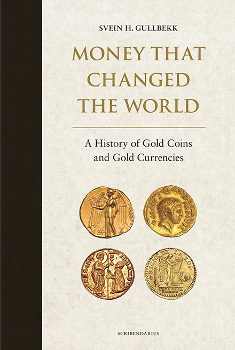By Ursula Kampmann
6 March 2014 – What Svein H. Gullbekk has dared to do is a bold venture. He attempted nothing less than to present money that changed the world: A History of Gold Coins and Gold Currencies, that is how the title of his 200 or so page monograph reads. The author is more than qualified. He is Professor of Cultural History at Oslo and is currently leading the international research project ‘Religion and Money: The economy of Salvation in the Middle Ages’. He has published a great number of books and articles on numismatics most of which do not so much address scholars but a broader interested audience. Thus, not academics are the target audience of his history of gold coins but laypeople that get an insight into the phenomenon of gold by a beautiful, lavishly illustrated overview.
Svein H Gullbekk, Money that Changed the World. A History of Gold Coins and Gold Currencies. Scribendarius, Oslo 2014. 234 p. 196 illustrations in colours. Hardback, 22.6 x 15.1 x 2.4 cm. ISBN-978-82-999453-0-1.
The spectrum ranges from ancient times to WW II. Of the gold coin types the best-known are presented in a well-written text that provides a mosaic of information without shedding too much light on the background regarding metal resources, the position of gold coins in the currency system or their role in economic life. The footnotes being omitted increases the readability of the text on the one hand but makes it quite difficult to verify the sometimes daring statements. It has to be said that the focus is not on gold coins as a phenomenon across time but on the individual piece what makes the book a very pleasing reading matter that is highly likely to delight every collector.
Hence, pointing at small mistakes must sound like carping. The next edition of the book, however, might well benefit from thorough editing. Then, sentences like Philipp II was depicted as riding a biga on his staters would be rectified (no Hellenistic ruler would have stooped to ride a chariot at the Olympic Games himself). Another statement that wouldn’t pass editing is “The first fiorino d’oro or florin was issued in 1252 by the Florentine Commune under the government of the Doge Giovanni Dandolo (1280-1289).”
These, however, are mere trifles. Generally speaking, “Money that changed the World” is a very nice book that presents gold coins from all over the world crossing all historic boundaries and offering collectors a first insight into this vast collecting area. And it is a real shame that authors seldom dare to approach topics in an epoch-spanning way.





